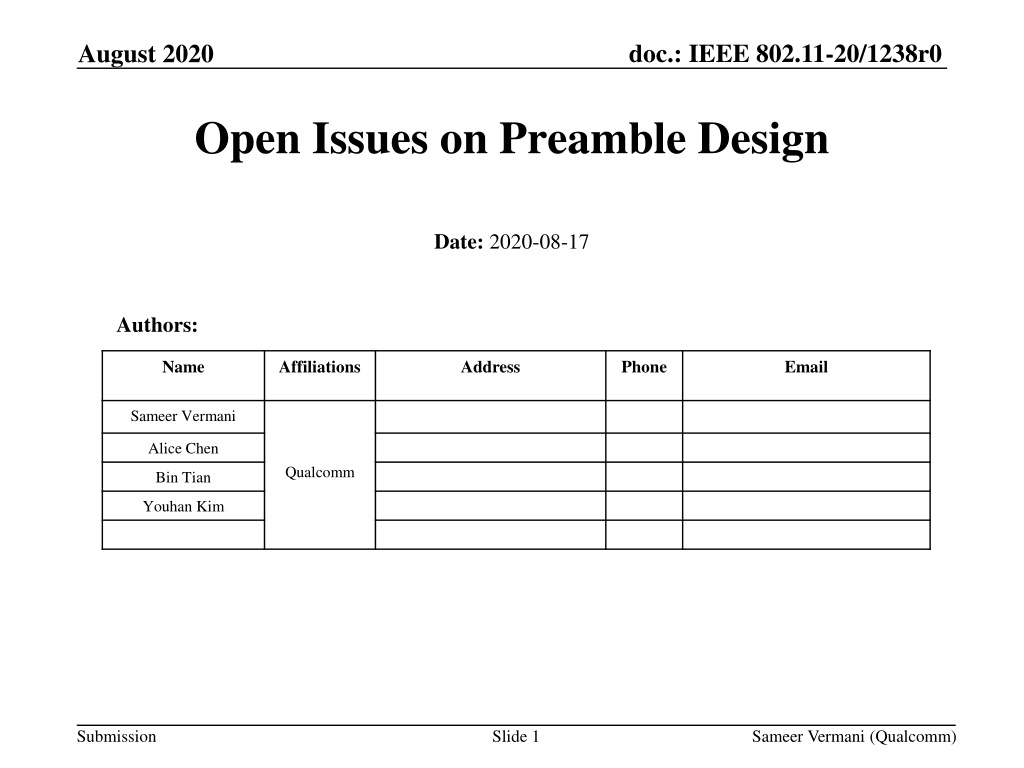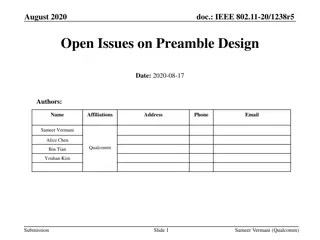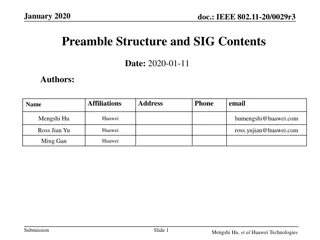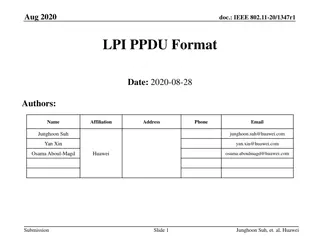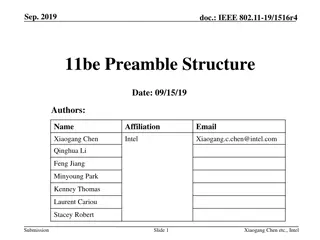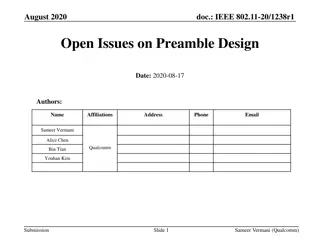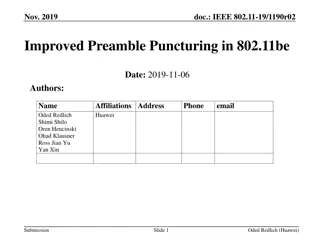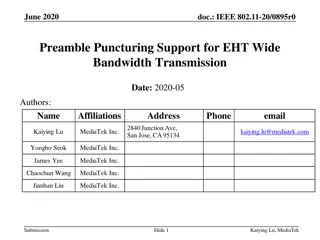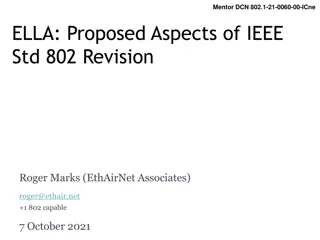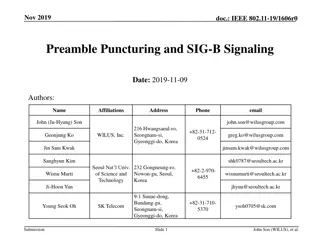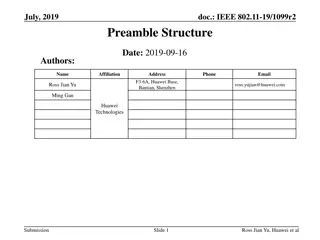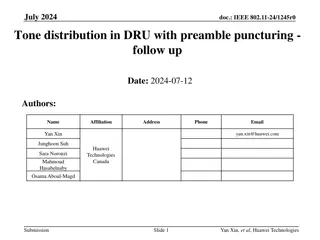Proposed Designs for IEEE 802.11-20 Preamble Design
In these slides, designs are proposed for U-SIG content and overflow for the Unified SU/MU PPDU as well as EHT-SIG design in IEEE 802.11-20. The focus is on punctured channel indication design to enable decoding of puncturing patterns by devices, with an emphasis on signaling efficiency and low overhead. The presentation outlines the background, specific design considerations, and the traits of the proposed solution to address these open issues.
Download Presentation

Please find below an Image/Link to download the presentation.
The content on the website is provided AS IS for your information and personal use only. It may not be sold, licensed, or shared on other websites without obtaining consent from the author. Download presentation by click this link. If you encounter any issues during the download, it is possible that the publisher has removed the file from their server.
E N D
Presentation Transcript
doc.: IEEE 802.11-20/1238r0 August 2020 Open Issues on Preamble Design Date: 2020-08-17 Authors: Name Affiliations Address Phone Email Sameer Vermani Alice Chen Qualcomm Bin Tian Youhan Kim Submission Slide 1 Sameer Vermani (Qualcomm)
doc.: IEEE 802.11-20/1238r0 August 2020 Introduction In these slides, we propose designs for the following 1. U-SIG content & overflow for the Unified SU/MU PPDU Punctured channel indication design is the focus 2. EHT-SIG design EHT-SIG common contents EHT-SIG content channel structure Compression Modes Coding structure User field format Submission Slide 2 Sameer Vermani (Qualcomm)
doc.: IEEE 802.11-20/1238r0 August 2020 Background: Punctured Channel Indication Previous motions 802.11be signaling in U-SIG for BW/puncturing information in every non-punctured 20 MHz of an 80 MHz segment shall allow even an OBSS or unassociated device to decode the puncturing pattern of at least the specific 80 MHz that contains the 20 MHz. [Motion 113, [9] and [46]] 802.11be supports BW field which does not include puncturing information. [Motion 112, #SP29, [9] and [46]] Based on above motions, U-SIG should be able to convey the preamble puncturing pattern of the relevant 80MHz to even an OBSS device In next slide, we propose a design which achieves this while keeping the signalling overhead low Note that low overhead for puncturing indication is desirable if we want to keep the EHT-SIG field length to 2 symbols for MCS0 SU transmissions More on this later Submission Slide 3 Sameer Vermani (Qualcomm)
doc.: IEEE 802.11-20/1238r0 August 2020 Punctured Channel Indication Design A single version dependent 6-bit (5 bit plus 1 reserved)field which conveys For non-OFDMA cases, the global puncturing information of entire PPDU BW for 11be BW dependent table shown in Appendix For OFDMA cases, the puncturing pattern of the current 80MHz 4 bits per 80MHz (simple bit-map) Enables OBSS devices to get puncturing info of the 80MHz being monitored in both cases Desirable traits of this proposal due to efficient signaling One reserved bit to leave room for future expansion of non-OFDMA puncturing modes Leaves room in U-SIG to accommodate additional TxOP/BSS Color bits if needed Ability to reduce EHT-SIG MCS0 overhead to 2 symbols for SU transmissions We will illustrate these traits in subsequent slides Submission Slide 4 Sameer Vermani (Qualcomm)
doc.: IEEE 802.11-20/1238r0 Category Version identifier August 2020 Subfield Bits 3 1 6 7 3 Field U-SIG/EHT-SIG contents UL/DL BSS color TXOP PPDU BW Punctured channel indication(global for non- OFDMA) Reserved PPDU format Reserved EHT-SIG MCS Number of EHT-SIG symbols EHT-SIG Compression CRC in U-SIG Tail in U-SIG Total # of Bits in U-SIG Spatial reuse GI+LTF size Number of HE-LTF symbols and midamble periodicity Version Independent 5 bit punctured channel indication in version dependent section in the U- SIG 1 reserved bit below it for future proofing 5 1 1 6 2 5 2 4 6 U-SIG Version Dependent 6 reserved bits in U-SIG Some of them can be moved to version independent section too Can be used for additional TxOP/BSS Color bits CRC & Tail 52 4 3 2 reserved bits in U-SIG overflow part of EHT-SIG-common 3 Version Dependent (U- SIG Overflow) Doppler 1 EHT-SIG Overflow bits kept to 17 to make sure EHT-SIG can fit to 2 symbols at MCS0 More on this later Pre-FEC padding 2 LDPC extra symbol segment Reserved PE disambiguity Total # of Overflow Bits 1 2 1 17 Submission Slide 5 Sameer Vermani (Qualcomm)
doc.: IEEE 802.11-20/1238r0 August 2020 EHT-SIG MCS We propose to lower the size of EHT-SIG MCS field in U-SIG to 2 bits 3-4 MCSs are more than enough to cover a good range of data rates for the SIG field One low, one medium and one high MCS should be sufficient Saves a bit in U-SIG Submission Slide 6 Sameer Vermani (Qualcomm)
doc.: IEEE 802.11-20/1238r0 August 2020 No STBC bit Propose to remove STBC from 11be With beamforming becoming a popular mode, open loop Tx diversity schemes like STBC offer limited appeal No signaling needed in SIG field Submission Slide 7 Sameer Vermani (Qualcomm)
doc.: IEEE 802.11-20/1238r0 August 2020 DUPed SU PPDU & Preamble Design The DUPed SU PPDU in R1 will use MCS0+DCM for 1ss and 2x Duplication, starting from 80MHz PPDU BW Achieve up to 4x combining gain in non-punctured case Propose a preamble design for up to 4x combining gain U-SIG is DUPed in every 20MHz within each 80MHz to achieve up to 4x combining gain EHT-SIG using the [1 1 1 1] content channel structure and MCS0 achieves up to 4x combining gain DUPed SU Content channel #1 U-SIG Overflow Common Field #User = 1 User Specific Field User field 1 PuncInfo Submission Slide 8 Sameer Vermani (Qualcomm)
doc.: IEEE 802.11-20/1238r0 August 2020 EHT-SIG Common Contents The EHT-SIG common field will include the following U-SIG overflow Repeated in each content channel to be friendly to 20MHz operating devices Total number of non-OFDMA users (3 bits for 1-8 users) Only present in the non-OFDMA compression mode Repeated in each content channel (similar to 11ax where the number of MU-MIMO users in the compression mode was carried in HE-SIG-A) RU allocation subfields (RUA) Only present in the uncompressed mode Contents are sent parallelized into two content channels This means that EHT-SIG Common Field is duplicated in both content channels for all modes other than the uncompressed mode Submission Slide 9 Sameer Vermani (Qualcomm)
doc.: IEEE 802.11-20/1238r0 August 2020 Overall EHT-SIG Content Channel Structure We propose two types of content channel structures for EHT SIG to cover different types of transmissions [ 1 1 1 1] Used for SU, DUPed SU and NDP packets Punctured channels will not be populated [ 1 2 1 2] Used for all transmissions other than SU, DUPed SU and NDP Punctured channels will not be populated May indicate the content channel being [1 1 1 1] through one of the compression mode bits state Submission Slide 10 Sameer Vermani (Qualcomm)
doc.: IEEE 802.11-20/1238r0 August 2020 Overall View of PPDU types and Content Channel Design EHT PPDUs Compression Mode Uncompressed mode SU transmission Non-OFDMA MU-MIMO DUPed SU [ 1 2 1 2] content channel [ 1 1 1 1] content channel NDP Submission Slide 11 Sameer Vermani (Qualcomm)
doc.: IEEE 802.11-20/1238r0 August 2020 Compression Modes The compression mode could signal three states State 0: Uncompressed OFDMA mode with [ 1 2 1 2] structure State 1: Used for SU, NDP (with 0 user), and DUPed SU (using [1 1 1 1] content channel structure) State 2: Used for non-OFDMA MU-MIMO with [1 2 1 2] structure U-SIG overflow needs to be 17 bits or lower for a 2 symbol EHT-SIG at MCS0 U-SIG overflow + 3 bits (#of users) + 22 (user-field)+10 bits CRC/tail needs to be within 52 bits SU and DUPed SU Content channel #1 U-SIG Overflow Content channel #2 U-SIG Overflow Common Field User Specific Field User field 1 User field 1 #User = 1 #User = 1 NDP Content channel #1 U-SIG Overflow Content channel #2 U-SIG Overflow Common Field Padding Padding Padding Padding or dummy user field to make length same as SU #User = 0 #User = 0 5-user MU-MIMO Content channel #1 U-SIG Overflow Content channel #2 U-SIG Overflow Common Field User Specific Field User field 2 User field 5 #User = 5 #User = 5 User field 1 User field 4 User field 3 Padding Submission Slide 12 Sameer Vermani (Qualcomm)
doc.: IEEE 802.11-20/1238r0 August 2020 EHT-SIG Coding Structure Common Field Non-OFDMA compression mode Use 1 code block to encode entire common field plus the 1st user field (or padding in a NDP) Uncompressed mode of 20/40/80MHz PPDU Use 1 code block to encode entire common field Uncompressed mode of 160/320MHz PPDU Use 2 code blocks 1st code block has fixed size (U-SIG overflow + 2 RUA = ~35 bits) 2nd code block includes all remaining RU allocation subfields (2 RUA in 160MHz, 6 RUA in 320MHz) User field Reuse 11ax like code block structure for every 2 user fields, and the last code block may have 1 or 2 user field(s), except for the following In non-OFDMA compression mode, 1st user field (or padding in a NDP) is encoded with the common field, the remaining user fields (if any) follow this rule Submission Slide 13 Sameer Vermani (Qualcomm)
doc.: IEEE 802.11-20/1238r0 August 2020 Reason for jointly encoding the common with 1st user field in compression mode The main motivation to use 1 code block to encode entire common field plus the 1st user field (or padding in NDP) in the non-OFDMA compression mode is to make the EHT-SIG fit into two MCS0 symbols for MCS0 for SU transmissions If the Common field and User Specific field are encoded separately, need 3 MCS0 symbols for total 62 bits Common field: 17 (U-SIG overflow)+3 (# user)+10 (CRC/tail)=30 bits User field: 22 (user info)+10 (CRC/tail) = 32 bits If the Common field and 1st user field are jointly encoded, need 2 MCS0 symbols 17 (U-SIG overflow)+3 (# user)+22 (user info or padding)+ 10 (CRC/tail)=52 bits Submission Slide 14 Sameer Vermani (Qualcomm)
doc.: IEEE 802.11-20/1238r0 August 2020 EHT-SIG User Field Design We propose a 22-bit 11ax like user field design to support up to 16ss Just expand NSTS and spatial configuration subfields to support more spatial streams Remove DCM bit since DCM is absorbed into MCS SU uses the non-MU-MIMO format of user field Subfield Number of Bits Subfield Number of Bits STA-ID 11 STA-ID 11 NSTS 4 Spatial Configuration 6 Beamformed 1 MCS 4 MCS 4 Reserved 1 Coding 1 Coding 1 User field for an MU-MIMO allocation User field for a Non-MU-MIMO allocation Submission Slide 15 Sameer Vermani (Qualcomm)
doc.: IEEE 802.11-20/1238r0 August 2020 Summary Proposed the following Puncturing channel information in U-SIG A single version dependent 5 bit field Interpreted differently for non-OFDMA vs OFDMA One reserved bit for future proofing U-SIG and EHT-SIG common contents Content channel structure for various PPDUs Use compressed mode field to differentiate between [1 1 1 1] structure vs [1 2 1 2] structure For compressed modes, encode the common information with the first user field Reduces preamble overhead of SU transmissions to 2 symbol EHT-SIG for even MCS0 Code block design for the uncompressed modes User field contents for EHT-SIG Submission Slide 16 Sameer Vermani (Qualcomm)
doc.: IEEE 802.11-20/1238r0 August 2020 SP1 Do you support punctured channel information field in U-SIG to be 5 bits + 1 reserved bit adjacent to it in the version dependent section ? For non-OFDMA cases it uses a BW dependent table to signal the puncturing pattern of the entire PPDU BW (all 11be patterns can be signaled) 1 reserved bit for possible future expansion (e.g, more puncturing patterns in R2) For OFDMA, it signals via a 4 bit field, which 20MHz channel(s) are punctured in the current 80MHz Interpretation of the field shall be dependent on the compression mode field Submission Slide 17 Sameer Vermani (Qualcomm)
doc.: IEEE 802.11-20/1238r0 August 2020 SP2 Do you agree with the EHT-SIG User Field Design shown on slide 15 of this document? Submission Slide 18 Sameer Vermani (Qualcomm)
doc.: IEEE 802.11-20/1238r0 August 2020 SP3 Do you agree that the EHT-SIG common field will include the following? U-SIG overflow Repeated in each content channel to be friendly to 20MHz operating devices Total number of non-OFDMA users (3 bits for 1-8 users) Only present in the non-OFDMA compression mode Repeated in each content channel (just like 11ax where the number of MU-MIMO users in the compression mode was carried in HE-SIG-A) RU allocation subfields (RUA) Only present in the uncompressed mode Contents are sent parallelized into two content channels Submission Slide 19 Sameer Vermani (Qualcomm)
doc.: IEEE 802.11-20/1238r0 August 2020 SP4 Do you agree that SU, SU with DUPed modulation and NDP packets shall use a [1 1 1 1] content channel structure for EHT-SIG? Submission Slide 20 Sameer Vermani (Qualcomm)
doc.: IEEE 802.11-20/1238r0 August 2020 SP5 Do you agree to use the compression modes field to signal the following? State 0: Uncompressed mode with [ 1 2 1 2] structure State 1: Used for SU, and DUPed SU (using [1 1 1 1] content channel structure) State 2: Used for non-OFDMA MU-MIMO with [1 2 1 2] structure Note: The exact naming of this field is TBD and whether this is split into two fields is TBD Submission Slide 21 Sameer Vermani (Qualcomm)
doc.: IEEE 802.11-20/1238r0 August 2020 SP6 Do you agree to encode the EHT-SIG common field together with the first user field for the non-OFDMA compressed modes? Submission Slide 22 Sameer Vermani (Qualcomm)
doc.: IEEE 802.11-20/1238r0 August 2020 SP7 Do you agree with the U-SIG and U-SIG overflow contents shown in slide 5? Ordering of fields is TBD TxOP/BSS Color bits are TBD Reserved bits will reduce if these fields get more bits Submission Slide 23 Sameer Vermani (Qualcomm)
doc.: IEEE 802.11-20/1238r0 August 2020 SP8 Do you agree for the EHT-SIG common field in the uncompressed mode, we will have the following coding structure for various BWs In case of 20/40/80 MHz, just 1 code block is present In case of 160/320MHz, 2 code blocks are present 1st code block has fixed size (U-SIG overflow + 2 RUA fields ) 2nd code block includes all remaining RU allocation subfields (2 RUA fields in 160MHz, 6 RUA fields in 320MHz) Submission Slide 24 Sameer Vermani (Qualcomm)
doc.: IEEE 802.11-20/1238r0 August 2020 NDP Indication, DUP Mode Indication, 5 bit puncturing info table and code block sizes APPENDIX Submission Slide 25 Sameer Vermani (Qualcomm)
doc.: IEEE 802.11-20/1238r0 August 2020 How to signal an NDP? Three options Option 1: Use the L-SIG length along with N_LTF and number of EHT-SIG symbols to tell that there is no data in this packet Similar way is used by 11ax and 11ac Option 2: Set the EHT-SIG MCS to 0 and number of EHT-SIG symbols to 1 Option 3: Use a state of the compression mode field to signal an NDP Main message: Don t need an explicit bit for signaling an NDP Submission Slide 26 Sameer Vermani (Qualcomm)
doc.: IEEE 802.11-20/1238r0 August 2020 How to signal DUP mode? Two options Option1: Use an un-used state of the EHT-SIG MCS field Have 3 valid MCSs and the fourth un-used state can be used to signal DUP mode. In DUP mode, EHT-SIG MCS is fixed to MCS0. Option 2: Use the last un-used state in the MCS field of the user field Main message: An explicit bit is not needed for signaling the DUP mode Submission Slide 27 Sameer Vermani (Qualcomm)
doc.: IEEE 802.11-20/1238r0 August 2020 Punctured Channel Indication Need 5 bits to indicate the allowed punctured patterns of the entire PPDU BW in 11be (covers all the non-OFDMA puncturing modes) PPDU BW Cases # of Entires 1 4 5 1 8 4 13 1 8 4 Note No puncturing 20MHz punctured Total No puncturing 20MHz punctured 40MHz punctured Total No puncturing 40MHz punctured 80MHz punctured 80MHz 160MHz 240/160+80MHz: [1 1 1 x], [1 1 x 1], [1 x 1 1], [x 1 1 1] For each contiguous 240MHz ([1 1 1 1 1 1 x x] and [x x 1 1 1 1 1 1]), one out of six 40MHz may be punctured [1 1 x x], [1 x 1 x], [x 1 1 x], [x 1 x 1], [x x 1 1] 320MHz 320-80-40 12 320-80-80 Total 5 30 Submission Slide 28 Sameer Vermani (Qualcomm)
doc.: IEEE 802.11-20/1238r0 August 2020 EHT-SIG Common Field Coding Compression Mode Content Channel Subfield in EHT-SIG Common Field 20MHz 40MHz 80MHz 160MHz320MHz U-SIG Overflow 17 3 N/A N/A 20 17 3 17 3 20 17 3 17 3 20 17 3 17 3 20 17 3 17 3 20 #1 Number of non-OFDMA users (0-8 users) U-SIG Overflow Number of non-OFDMA users (0-8 users) Total # of Signaling Bits in One Content Channel Code Block Size in One Content Channel (including 1 user field, CRC & Tail) U-SIG Overflow Odd indexed 20MHz RU allocation subfield(s) U-SIG Overflow Even indexed 20MHz RU allocation subfield(s) Total # of Signaling Bits in One Content Channel Code Block #1 Size in One Content Channel (including CRC & Tail) Code Block #2 Size in One Content Channel (including CRC & Tail) Non-OFDMA (Includes SU, non-OFDMA MU-MIMO, DUPed SU) #2 52 52 52 52 52 17 9 N/A N/A 26 17 9 17 9 26 17 18 17 18 35 17 36 17 36 53 17 72 17 72 89 #1 #2 Uncompressed 36 36 45 45 45 N/A N/A N/A 28 64 Submission Slide 29 Sameer Vermani (Qualcomm)
